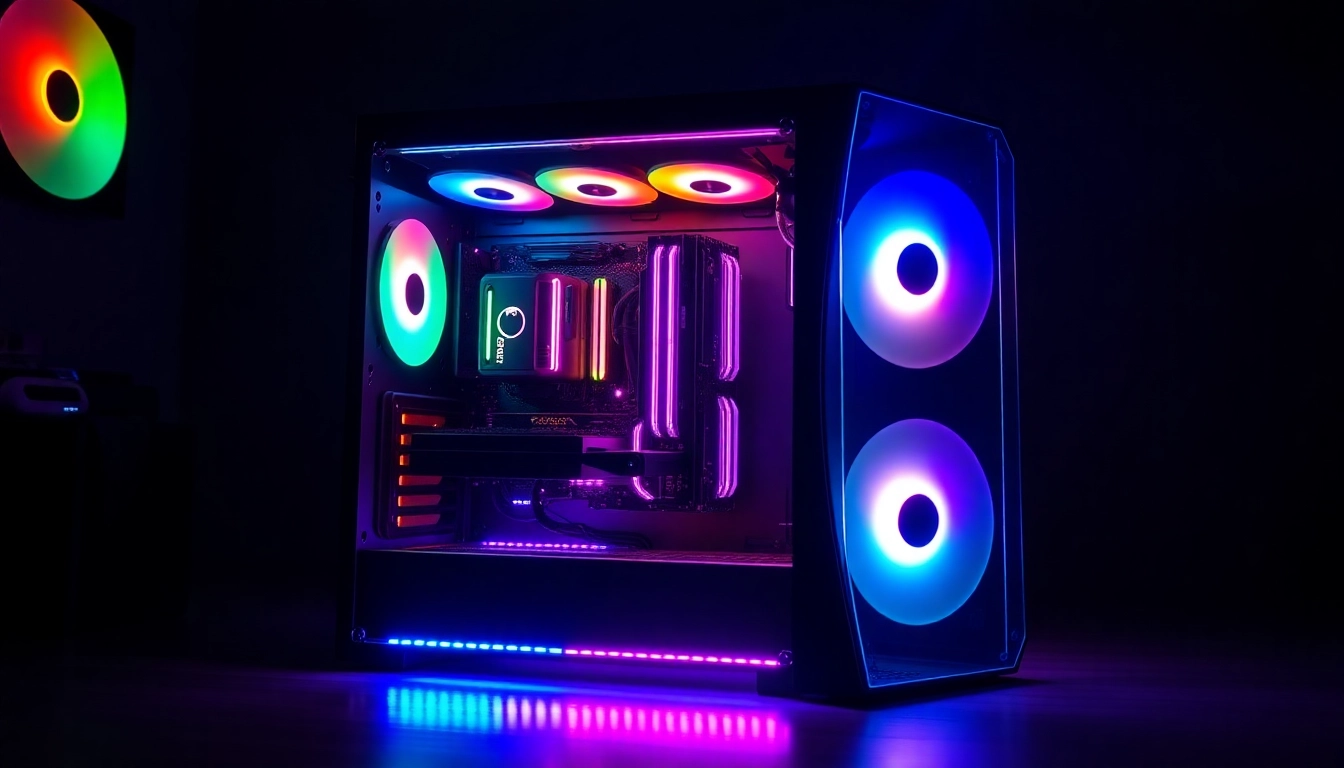Crafting the Perfect Custom Gaming PC Case: Design Ideas and Functionality
Understanding Custom Gaming PC Cases
In an era where gaming has transcended mere entertainment into a full-fledged culture, personalizing your gaming rig is not just a trend; it’s a statement of individuality and performance. A custom gaming pc case serves as both a protective enclosure for your critical hardware and a canvas for expressing your style. Whether you are a casual gamer or a professional eSports player, the right case can enhance your gaming experience, display your unique aesthetic, and improve the functionality of your setup.
What is a Custom Gaming PC Case?
A custom gaming PC case refers to a personalized chassis designed to house all the essential components of a gaming PC, such as the motherboard, GPU, CPU, storage devices, and power supply. These cases can vary dramatically in size, shape, and design, allowing users to select or modify them to meet specific needs. Custom cases often feature enhanced airflow systems, sound-dampening materials, and spaces for advanced cooling solutions, presenting a perfect marriage between functionality and aesthetic appeal.
Benefits of Custom Cases for Gamers
Custom cases offer several distinct advantages over standard off-the-shelf options:
- Enhanced Airflow: Custom cases often incorporate thoughtful designs that improve airflow and cooling efficiency. This is crucial for gamers whose hardware generates substantial heat during intensive gaming sessions.
- Personalization: Gamers can express their personality through unique designs, colors, lighting effects, and materials that standard cases may not provide.
- Improved Cable Management: Dedicated compartments and pathways for cables not only improve aesthetics but also optimize airflow around the components.
- Durability: Many custom cases utilize high-quality materials that enhance the durability and lifespan of the PC, protecting valuable components from dust and damage.
Key Features to Look For in a Gaming PC Case
When considering a custom gaming PC case, it’s vital to focus on specific features:
- Size Compatibility: Ensure the case fits your components, including motherboard form factors (ATX, Micro ATX, Mini ITX) and GPU lengths.
- Cooling Options: Look for cases with support for multiple fans, liquid cooling systems, and proper ventilation to prevent overheating.
- Expansion Slots: Custom build enthusiasts may require additional slots for future upgrades, so look for cases with extra space.
- Build Quality: Opt for cases that are made from high-quality materials like steel and tempered glass, offering both aesthetics and longevity.
- Ease of Assembly: Features such as tool-less drive bays and removable panels can simplify the building and upgrading process.
Types of Custom Gaming PC Cases
Form Factors: ATX vs. ITX
The form factor of a case determines its compatibility with various PC components. The two common types are ATX and ITX:
- ATX Cases: These cases are larger and accommodate standard ATX motherboards, providing ample space for multiple GPUs, storage drives, and efficient cooling solutions. They typically offer a better airflow system and are ideal for high-end gaming rigs that require additional space for future upgrades.
- ITX Cases: Smaller and designed for Mini ITX motherboards, ITX cases are perfect for compact builds or gaming setups with limited desk space. Although they provide less room for additional hardware, they still can offer impressive cooling options and aesthetic customization features.
Material Choices: Metal, Acrylic, and More
The materials used in custom gaming PC cases affect aesthetics, weight, durability, and heat dissipation:
- Metal: Steel and aluminum are popular choices due to their strength, durability, and excellent heat resistance. Metal cases are robust and provide a sense of premium quality.
- Acrylic: Acrylic plastic offers a lightweight and affordable alternative. While it’s prone to scratching, it can be shaped into unique designs and offers a transparent view of the internal components.
- Tempered Glass: Many modern gaming cases feature tempered glass panels for enhanced visual appeal. This material provides a clean, clear view of the internal components while being sturdy and resistant to scratches.
Design Aesthetics: RGB and Personalized Art
Design plays a critical role in a gamer’s overall setup, with many opting for custom cases that feature:
- RGB Lighting: Integrated lighting systems allow for colorful lighting effects that can sync with games or music, enhancing the gaming atmosphere.
- Customized Artwork: Some manufacturers offer printing options, allowing gamers to apply personal graphics, logos, or artwork to their cases, making their gaming rig truly unique.
- Modular Designs: Cases that allow for add-ons or modifications can be personalized to a greater degree, whether it’s through external lighting or additional fans.
Building Your Custom Gaming PC Case
Essential Tools for Case Modification
Modifying a custom gaming PC case can require some specific tools, including:
- Screwdrivers: A set of screwdrivers (flathead and Phillips) for assembling and disassembling components.
- Modding Tools: Dremels or hand saws for any custom cuts needed for fans, cooling systems, or cable management solutions.
- Paint Supplies: If you’re opting for a custom paint job, you’ll need spray paint, masking tape, and safety equipment (masks, gloves).
- Ruler and Measuring Tape: For precise measurements to ensure all components fit properly.
Step-by-Step Guide to Assemble a Custom Case
Here’s a comprehensive guide to successfully assembling your custom gaming PC case:
- Select Your Components: Choose a compatible motherboard, CPU, GPU, and other peripherals. Ensure they fit within your selected case.
- Remove Panels: Open your custom case by removing its side and front panels. This will provide better access during assembly.
- Install the Power Supply: Mount the power supply unit (PSU) first, as it often dictates the layout of other components.
- Attach the Motherboard: Secure the motherboard to standoffs corresponding to its form factor, ensuring all ports are accessible.
- Add Drives: Install your hard drives and SSDs in the appropriate bays while ensuring proper cable management.
- Install the GPU: Slot the GPU into the motherboard, securing it with screws, and ensure adequate clearance for airflow.
- Cable Management: Connect all cables including power, data, and fans, ensuring minimal clutter for improved airflow.
- Close Panels: Replace the case panels securely and test the build by powering on the PC.
Common Mistakes to Avoid in Custom Builds
To achieve the best results, be aware of these common pitfalls:
- Neglecting Airflow: Poor airflow can lead to overheating; thus, ensure that fans are positioned correctly to facilitate cool air intake and hot air exhaust.
- Incompatible Components: Confirm that all chosen hardware is compatible with one another, particularly in terms of size and power requirements.
- Ignoring Cable Management: Cluttered cables inhibit airflow and can lead to difficulties during maintenance. Always plan your cable management strategically.
- Overlooking Driver and Software Installations: After building, don’t forget to install the necessary drivers for optimal performance.
Personalizing Your Gaming PC Case
Custom Paint Jobs and Vinyl Wraps
Many gamers love to personalize their cases through painting or wrapping. Here’s how:
- Paint Jobs: Using spray paint specifically designed for plastic or metal can create vibrant and personalized looks. Remember to sand the surface for good adhesion and apply a primer before the color coat.
- Vinyl Wraps: A more versatile option, vinyl wraps can cover large areas with unique colors or patterns. They’re also removable, allowing for easy updates.
Adding Unique Accessories and Hardware
Consider enhancing your custom gaming PC case with unique accessories:
- LED Strips: Easily installed around the case edges to add a dynamic lighting effect.
- Custom Fans: RGB fans not only improve cooling but can add aesthetic appeal with colors and lighting modes.
- Upgraded Cooling Solutions: Liquid cooling systems can be incorporated seamlessly, not just for temperature control, but also for unique visual flair.
Engraving and Laser Etching Options
For those looking for a more permanent aesthetic upgrade, options such as:
- Engraving: Personal logos or intricate designs can be etched into the surface of the case with precision laser tools.
- Custom Panels: Replace standard panels with custom-printed glass or acrylic featuring personal artwork or themed visuals.
Where to Buy Custom Gaming PC Cases
Top Online Retailers for Custom Cases
Numerous retailers cater to the custom gaming PC market, offering various cases. Some of the most reputable include:
- HYTE – Known for customizable designs and quality manufacturing.
- Vyral – Offers unique custom prints on full cases and panels.
- Starforge Systems – Provides DIY cases with exquisite artistic designs.
Comparing Prices and Customization Options
While customizing your gaming PC case, it’s important to compare prices across different vendors. Consider shipping costs, potential import duties for international purchases, and any additional fees for custom artwork or specialized features.
Community Recommendations: Best Custom Cases
Forums like Reddit’s BuildAPC and various online gaming communities can provide insights and recommendations for the best custom gaming cases based on real user experiences. Engaging with these platforms can help to uncover hidden gems or updates on the latest trends in the custom case market.



